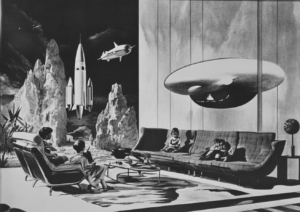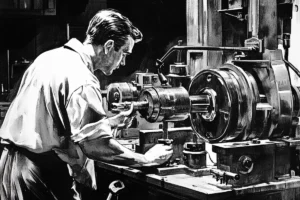Recently, a LinkedIn post by a business cultural expert poked my memory of Clayton Christensen’s Jobs To Be Done (JTBD) theory. Another ‘theory’ we hear about over our careers. With my recent focus on Anthropology in Marketing, I thought it might be time to revisit the concept. I’ll follow up with some ideas on executing these ideas, especially in a B2B environment.
JTBD theory reframes how we understand why people buy things. Instead of simply purchasing products, customers “hire” products or services to perform specific jobs that solve problems or fulfil needs. A classic illustration (often attributed to Theodore Levitt) is that nobody wants a quarter-inch drill; what they want is a quarter-inch hole. In other words, people seek the outcome (the job done), not the product for its own sake. This perspective urges marketers and innovators to focus on the purpose a customer is trying to achieve – the progress they seek – rather than on product features alone.
Christensen’s idea can be extended by looking beyond the apparent functional job. It suggests seeing the world “through the lens of humanity”, meaning we should consider not just the functional task a product accomplishes but also the deeper emotional and social jobs it performs for people. So, let us work with the idea of a marketing campaign that creates “a little bit of joy” as an example of a human emotional job that a brand can fulfil. In this reflective analysis, we will explore the author’s intent in evolving Christensen’s theory, explain what that may signify, discuss why going beyond functional benefits matters, and consider the broader marketing and philosophical implications of this human-centred framing.
Extending Christensen’s Theory Beyond the Functional
Christensen’s original JTBD theory already acknowledges that jobs have multiple dimensions: “Jobs are never simply about function—they have powerful social and emotional dimensions.”. In other words, when someone “hires” a product, they not only aim to accomplish a functional task, but they often have emotional motives (how it makes them feel) and social motives (how it helps others perceive them) intertwined with that job For example: when hiring a fast-food milkshake, commuters were not just quenching hunger (functional); they were also alleviating boredom on a long drive (an emotional job, turning a dull commute into a small moment of enjoyment). Likewise, buying a particular clothing brand might fulfil a social job of signalling status or identity to peers.
I want to build on this foundation by urging marketers to actively consider all three types of jobs—functional, emotional, and social—in customer engagement.
They caution against the “myopia of categorical benefits,” meaning the narrow view of a product only within the confines of its category’s usual features or advantages. Christensen’s framework encourages breaking out of that myopia; as one practitioner notes, “product people tend to oversimplify the framework by focusing only on… functional jobs,” often neglecting emotional and social needs. By contrast, I would argue that marketers should “look outside” of just those category-defined benefits and see “the world through the lens of humanity” – essentially, to see customers as whole humans with broader goals, feelings, and social contexts.
Under this extended view, a company should ask, “What functional job is our product hired for?” and “What emotional job and what social job is our offering doing for the person?”. Christensen himself has indicated that the most successful innovations address all dimensions of a job. In Competing Against Luck, he and his co-authors stress that a job’s functional, social, and emotional components can be “equally important” in why a customer chooses a product. My thoughts echo this: The better a branded product performs against all three jobs (functional + emotional + social), the more compelling the offering. In short, I am building on Christensen’s theory by pushing marketers to integrate emotional and social value into the core value proposition, not treat them as afterthoughts.
The Human Emotional “Job”: A Little Bit of Joy
I want to focus here on “the human emotional ‘job’: a little bit of joy.” The specific emotional outcome that a product or brand can deliver—a small dose of happiness or delight—that might transcend the product’s immediate functional purpose. By calling it the “human” emotional job, I am implying it is a near-universal emotional “desire”, not just something tied to a product category.
Here is an example: window and door company (Pella) that traditionally might emphasise a functional job (providing a well-performing window, insulation, security, etc.) and perhaps an obvious category-specific emotional job (the feeling of safety or comfort from sturdy, secure windows). Instead, this company centred its messaging on “making life a little brighter,” literally and figuratively. Brighter life hints at sunlight and warmth, but more importantly, joy – the simple happiness of a sunlit room or an uplifting view. In other words, Pella shifted focus to the emotional job of bringing a bit of joy into people’s homes. In this case, the drill is the window; the “hole in the wall” is not just letting light in but letting joy in.
So, “a little bit of joy” represents the idea of a product fulfilling an emotional need for positivity, delight, or uplift in the customer’s life. It is the emotional payoff that goes beyond utility. This concept is aligned with what design and marketing experts often call customer delight. For instance, in the milkshake example, the real win was realising the product could turn a tedious morning routine into a moment of enjoyment – essentially, giving the commuter a small spark of happiness to start the day. Many successful products intentionally aim to deliver such moments of joy: think of a smartphone app whose intuitive design “just makes you happy” using it or a coffee maker that brews coffee and makes the morning ritual feel comforting and joyful. Those feelings of satisfaction and joy are emotional jobs being fulfilled.
I am sure someone will find joy in the sound of a giant rock-crushing machine.
By emphasising joy, marketers should ask: “How does our offering make people feel happier, even in a small way?” This is a more human-centric question than merely asking how the product works. Joy is one of the fundamental positive emotions; tapping into it can create a strong emotional bond. Indeed, research on emotional branding supports that meeting emotional needs (like the need for enjoyment, happiness, pride, etc.) can inspire greater customer loyalty. The point is that delivering a little joy can be a game-changer even in so-called mundane or “low involvement” categories. It elevates the product from a commodity to something that resonates with the human spirit.
Beyond Functional and Categorical Benefits
Why is it so valuable for marketers to go beyond just the functional features or standard category benefits of their products? Focusing solely on the functional job is limiting—it is a necessary part of an offering but insufficient for a truly compelling brand promise. There are likely dozens of competitive products that do exactly the same thing. Customers make choices based on deeper motivations than just product specs. In Christensen’s words, “jobs are never simply about the functional—they have important social and emotional dimensions, which can be even more powerful than functional ones”. This means a product might technically satisfy a need, but what often drives the decision are the feelings and social implications associated with it. For example, high-end electric and essential economy cars can get you from A to B (functional). However, they evoke different emotions and signals about the owner (pride, excitement, status vs. pragmatism). These emotional and social factors heavily influence willingness to pay and brand preference.
Human emotional jobs push marketers to unlock these deeper levels of value. By looking outside the myopia of categorical benefits, they encourage brands to break out of conventional thinking like “we are just a window company” or “just a low-involvement product.” This recalls Theodore Levitt’s idea in Marketing Myopia that industries fail when they define themselves too narrowly (e.g. railroads thinking they are just in the railroad business rather than in transportation) (Marketing Myopia – Harvard Business Review). Similarly, a window manufacturer that only sees itself as selling glass and frames might miss the chance to sell a brighter, happier home life. Pella subverts this myopia and recognises the broader human context – “seeing the brand’s humanity”.
From a practical marketing standpoint, going beyond functional benefits can differentiate a brand and make its story more compelling. Functional excellence is expected (every window should keep out the rain); emotional and social benefits are where a brand can stand out. Pella moved past even the obvious categorical emotional ‘job’ and chose a less expected but more uplifting emotional angle.
Any company might claim security (feeling safe) as an emotional benefit; joy is a more aspirational human benefit that creates a stronger connection. By addressing emotional jobs (like bringing joy or reducing guilt) and social jobs (like helping customers feel proud or connected), marketers can create what one JTBD expert calls a “holistic harmony” of value. All these layers work together to make the offering much more persuasive than functional perks alone.
There is also a strategic payoff to this approach. When a company understands the full spectrum of jobs its product is hired for, it can innovate and evolve to keep it relevant. Christensen argued that defining your business around the customer’s job (rather than your product features) is key to long-term success. Suppose you know customers are “hiring” your product to bring them a little joy (emotional job) and perhaps to show they care about a cozy home for their family (social job). In that case, you can tailor your marketing messages, innovation pipeline, and customer experience to excel at those jobs. This could mean adding new features or services that amplify joy (like customisable window sun-catchers that cast beautiful light patterns) or that enhance social value (maybe a community or social media sharing of “views through my Pella window” that builds a sense of pride and belonging). The key is that you are no longer competing only on product specs; you are competing on delivering human value, which is often far more complicated for competitors to copy or commoditise.
In summary, marketers have tremendous value in expanding their focus beyond the functional. It is about recognising that “people aren’t just buyers; they are job executors” with complex lives and aspirations. By addressing emotional and social jobs, a brand can move from being just another option to becoming a meaningful part of the customer’s life story. It transforms marketing from a transactional pitch into a service to the customer’s deeper needs.
Broader Implications: A Human-Centric Marketing Philosophy
There is a philosophical undercurrent: marketing should be rooted in genuine human understanding and empathy. Phrases like “engaging humanity” and seeing through “the lens of humanity” signal an approach where the marketer steps into the customer’s shoes and asks, “What is this person trying to do or feel in life, and how can we help?”. Christensen described the JTBD perspective as causing you to “crawl into the skin of your customer and go with her as she goes about her day,” relentlessly asking why she does what she does. This is an exercise in empathy, akin to design thinking and human-centred design principles. The author of our passage reinforces that ethos by encouraging marketers to empathise with the human behind the customer rather than analyse a consumer segment.
Another implication in the author’s enthusiastic tone, “This is so good… kudos on making people FEEL”, is that marketing can aspire to impact people’s lives positively, not just inform them about a product. By delivering “a little bit of joy,” a brand takes on a more meaningful role. This borders on a purpose-driven view of marketing – where a company’s mission might be to improve customers’ well-being (even in small ways) alongside selling its product. The author’s applause (“Bravo”) for focusing on joy suggests a belief that brands, even in everyday categories, can contribute to human happiness or emotional well-being. It is a subtle but powerful reframing: a window company is not just making windows, it is “making life a little brighter”. This kind of language is reminiscent of brands that define a higher purpose for themselves – for example, a laundry detergent brand talking about “caring for your family’s comfort” rather than just cleaning clothes, or a tech gadget brand saying it “connects people” rather than just touting specs.
Philosophically, the author’s interpretation of JTBD aligns marketing with the idea of serving human needs in a holistic sense. It suggests that any product, no matter how utilitarian, can be positioned in terms of the human value it delivers. This challenges marketers to be more creative and empathetic. It also has implications for how companies measure success: Beyond customer satisfaction with the product, are we bringing some positive emotion or social value to people? Companies should consider metrics like emotional resonance or brand empathy in addition to traditional KPIs.
Finally, the framing implies a more resilient marketing strategy. If you connect with customers emotionally, you often foster loyalty and community. As the consulting firm Brandtrust observes, “Customer trust and loyalty depend on executing these emotional jobs above any other criteria”. People tend to stick with brands that feel right to them, that get them. By focusing on emotional jobs like joy or social jobs like identity, marketers can cultivate that sense of “this brand understands me as a person”. In an age where consumers have endless choices, such deeper connections are a strong defence against competition.
Conclusion
Jobs To Be Done theory invites us to shift our perspective from products to people. Christensen instructed us to ask, “What job is the customer hiring this product for?” – a question that already shifts the focus to customer needs and outcomes. This author goes one step further, urging us to consider all the jobs that matter in a person’s life: not just the functional task but the emotional uplift and social fulfilment a solution can provide. By considering something as simple and profound as “a little bit of joy” to be part of the product’s job, the author extends the JTBD framework into a more humanistic marketing philosophy.
This means designing and marketing products with empathy – understanding that a great offering performs on multiple levels. Yes, it does the basic job well. However, it also makes the user feel good (perhaps proud, excited, relieved, or joyful). It helps them be good in the eyes of others or themselves (fitting into a social narrative or identity). When a brand delivers on these functional, emotional, and social jobs together, it transcends being just a product. It becomes a partner in the customer’s journey of life.
In the end, marketing is most effective when it speaks to humans as humans. By focusing on the little joys and the bigger emotional/social jobs, marketers can craft offerings and stories that solve problems and enrich lives. This holistic approach is not just a formula for a compelling value proposition – it is a vision for marketing that treats customers as whole people seeking a bit of happiness and meaning, not just shoppers checking off a list. Moreover, as Christensen’s theory and its commentators suggest, when you help someone make the progress they genuinely care about, they are not just buying your product – they are enthusiastically hiring you to improve a part of their life.
Sources:
- Christensen, C. M., et al. Competing Against Luck: The Story of Innovation and Customer Choice. (2016) – Summarised key idea that jobs-to-be-done include functional, social, and emotional dimensions (Competing Against Luck | The Story Of Innovation And Customer Choice by Clayton M. Christensen, Taddy Hall, Karen Dillon, David S. Duncan | The Mihir Chronicles) (Competing Against Luck | The Story Of Innovation And Customer Choice by Clayton M. Christensen, Taddy Hall, Karen Dillon, David S. Duncan | The Mihir Chronicles).
- Christensen, C. M. “Know Your Customers’ ‘Jobs to Be Done’.” Harvard Business Review. (2016) – Introduced the “hire a product to do a job” concept and emphasised that jobs are not just functional (Jobs to Be Done: 4 Real-World Examples | HBS Online) (Jobs to Be Done: 4 Real-World Examples | HBS Online).
- Brandtrust Insights. “Jobs-to-be-done: Satisfying Your Customers’ Highest Needs.” (2024) – Discusses fulfilling functional, emotional, and social needs simultaneously and how emotional jobs (e.g. feeling joy or guilt-free) drive consumer behaviour (Jobs-to-be-done: Satisfying Your Customers’ Highest Needs | Brandtrust) (Jobs-to-be-done: Satisfying Your Customers’ Highest Needs | Brandtrust).
- LogRocket Blog – Krawczyk, B. “Understanding the 3 types of jobs to be done.” (Nov 2023) – Notes that focusing only on functional jobs leads to missed opportunities, advocating that emotional and social jobs must be addressed for full benefit (Understanding the three types of jobs to be done – LogRocket Blog) (Understanding the three types of jobs to be done – LogRocket Blog).
- Marcus Collins (2025) – Commentary on Pella Windows campaign (via LinkedIn post) highlighting the application of JTBD in branding: Pella shifted from a functional/security message to an emotional promise of “a little bit of joy”, exemplifying a human-centric approach (This!!!! Is The Justis Department!!!! Amber Justis (She/Her/Hers) and her… | Jean Batthany).
- Levitt, T. “Marketing Myopia.” Harvard Business Review. (1960) – Classic marketing essay urging businesses to define themselves by customer needs (the hole), not by-products (the drill) (Jobs-to-be-done: Satisfying Your Customers’ Highest Needs | Brandtrust) (Marketing Myopia – Harvard Business Review). This ethos underpins the JTBD mindset adopted by the author.




